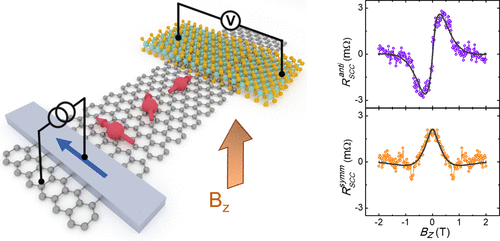Large multi-directional spin-to-charge conversion in a low symmetry semimetal at room temperature

Symmetry is a unifying principle that governs all aspects of physics. The physical properties of crystalline solids are no different. But, as symmetry is progressively lowered through the 32 crystallographic point groups, novel transport effects emerge. Crystal symmetry dictates also the geometry of a phenomenon that has attracted a lot of attention in recent years, the spin Hall effect (SHE) or its reciprocal, which enables the interconversion between charge and spin currents.
SHE is the accumulation of particles with opposite spin on the opposite surfaces of a material in which a current is flowing. However, an external magnetic field destroys the effect. SHE is due to spin-orbit coupling and this coupling can be intrinsic or extrinsic to the material: The intrinsic mechanism is a consequence of the band structure of the material, whereas the extrinsic mechanism stems from scattering of the charge carriers by impurities that locally induce spin-orbit coupling. In conventional spin Hall materials, high crystal symmetry imposes that injecting a charge current density can only result in a transverse spin current density with a spin polarization orthogonal to both densities or, in simpler terms, spin current, charge current and spin polarization are mutually perpendicular.
SHE, or its reciprocal – inverse SHE, are crucial effects for the electrical generation or detection of spin currents, something required in spintronics applications such as spin-orbit torque memories and spin-based logic devices. Lifting the constraints imposed by high crystal symmetry and, consequently, enabling unusual spin-to-charge conversion geometries in low-symmetry crystals would facilitate these applications.
Transition metal dichalcogenides, layered materials with strong spin-orbit coupling, are an ideal playground to observe not only conventional SHE, but also some of these unconventional SHE configurations in their low-symmetry crystalline phases. One of such materials is MoTe2, which appears in semimetallic, distorted 1T octahedral phases, namely 1T’ and 1Tdstructures, which can be found at room and low temperatures, respectively.

Now, a team of researchers report 1 the observation and quantification of spin-to-charge conversion of spin currents injected in MoTe2 by spin absorption from graphene, with magnetic-field-induced full control of the spin polarization direction.
The researchers find, apart from a highly efficient conventional, orthogonal, spin-to-charge conversion, a simultaneous an unconventional non-orthogonal one. This geometry, parallel to the spin orientation, is unexpected as it remains forbidden by the mirror symmetry of the room temperature 1T’ phase. Something that can be only explained if the mirror plane of MoTe2 is broken in the samples, most likely due to fabrication-induced shear strain.
Regardless of the origin, this new system, where any in-plane polarization of injected spins results into charge conversion, brings new flexibility to the design of spin logic devices. Inversely, the ability to obtain spin currents with any in-plane spin polarization by applying electrical current along a single direction is a promising feature for spin-orbit torque memories, current-induced domain wall and skyrmions motion-related applications.
Author: César Tomé López is a science writer and the editor of Mapping Ignorance
Disclaimer: Parts of this article are copied verbatim or almost verbatim from the referenced research paper.
References
- C. K. Safeer, Nerea Ontoso, Josep Ingla-Aynés, Franz Herling, Van Tuong Pham, Annika Kurzmann, Klaus Ensslin, Andrey Chuvilin, Iñigo Robredo, Maia G. Vergniory, Fernando de Juan, Luis E. Hueso, M. Reyes Calvo, Fèlix Casanova (2019) Large multi-directional spin-to-charge conversion in low symmetry semimetal MoTe2 at room temperature Nano Letters doi: 10.1021/acs.nanolett.9b03485 ↩